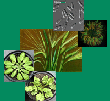| Beck, E; Mägdefrau, K; Senser, M: Globular mosses, Flora, 178, 73-83 (1986), doi:10.1016/S0367-2530(17)31476-7 | |
| Abstract: On bare soils, subjected to subarctic climate conditions, lenticular to spherical moss balls have been observed which were completely unattached to the substratum, This article summarized the present knowledge on this unique life-form of foliar mosses, starting with a short treatise on the history of discovery. Then the geographical distribution of globular mosses on the subantarctic islands, the subarctic regions and in the temperate zone is reported. Abundantly, moss balls occur in the alpine zone of high mountains in tropical Africa, especially on Mt. Kenya. A taxonomic approach (Table 1) revealed that globular mosses are representatives of acrocarpous genera which usually form dense hemispherical cushions. As shown by the material from Mt. Kenya [Grimmia ovalis (Hedw.) Lindb.] the globoid shape originates by continual motion either of fragments of moss cushions which have been ruptured by frost or of single moss plants or small aggregations thereof which form a loose carpet on otherwise bare soil. Wind and solifluction which is due to nocturnal needle-ice formation and thawing of the soil in the day time could be demonstrated by two field experiments as moving forces. Structural analysis of the 0.5 to 8 cm large balls of Grimmia ovalis showed three zones: The outer layer of living parts is followed by a zone of morphologically intact but dead sections of the plants while the core consists of a peaty material composed of disintegrated leaflets, rhizoids and stems and of minute soil particles as well. The velocities of uptake of water and of methylene blue (as a model substance for cationic nutrients) into a spheroid of Grimmia ovalis has been determined under field conditions. |

